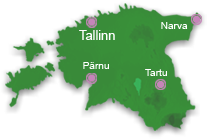| Companies | Tourist Attractions & Sightseeing | Map Search |
Matsalu National Park07.September 2012
Matsalu National Park (previously Matsalu Nature Reserve) is a nature reserve and national park situated in Lääne County, Estonia.
Matsalu Bay is one of the most important wetland bird areas in Europe, due to its prime position on the East Atlantic Flyway. Large numbers of migratory birds use Matsalu as a staging area. Every spring over two million waterfowl pass Matsalu, of which around 1.6 million are Long-tailed Ducks. Matsalu National Park is a home for a number of endangered species, many of which are listed in the Estonian IUCN Red List, including the White-tailed Eagle of the highest conservation category, a lot of bird species of the second and third protection categories, 22 strongly protected plant species, the Natterjack Toad, and ten species of mammals of the second conservation category.
Kasari River is the biggest of several rivers that run into Matsalu Bay. The delta of the Kasari River is not in its natural condition due to dredging between 1930 and 1960; the alluvial meadow of the delta, most of which is actively managed, is one of the biggest open wet meadows in Europe. Reeds and rushes surrounding the main channel expand westwards up to 100 m every year.
A total of 282 bird species have been recorded in Matsalu, among which 175 are nesting and 33 are transmigrant waterfowl. 49 species of fish and 47 species of mammals are registered in the area of the nature reserve, along with 772 species of vascular plants. Every spring over two million waterfowl pass Matsalu, including 10,000—20,000 Bewick's Swans, 10,000 Greater Scaups, Common Goldeneyes, Tufted Ducks, Goosanders and many others. A colony of up to 20,000 Barnacle Geese, over 10,000 Greylag Geese and thousands of waders stop on the coastal pastures in spring. The most numerous birds of passage (around 1.6 million) are Long-tailed Ducks. Approximately 35,000—40,000 ducks feed in the reedbeds in spring.
History
Scientific research in Matsalu started around 1870, when Valerian Russow, the curator of the Natural History Museum of the University of Tartu, gave a short overview of birds near Matsalu Bay. Between 1928 and 1936 Eerik Kumari researched birds in Matsalu and suggested a creation of the bird protection area there in 1936. In 1939, parts of the bay (Virtsu-Puhtu) were protected for mud used in mud-baths.
Research in Matsalu became regular in 1945, when the Institute of Botany and Zoology of the Estonian Academy of Sciences established a research base in Penijõe. Matsalu Nature Reserve was founded in 1957, mainly to protect nesting, moulting and migratory birds. The first permanent workers (administrators and scientists) started in 1958 and the Penijõe research base became the administrative centre of the newly created nature reserve. The Estonian Bird Ringing Centre, the coordinator of bird ringing in Estonia, is also located in Penijõe. In 1976, Matsalu was included in the list of wetlands of international importance under the International Convention on the Protection of Wetland. The European Diploma of Protected Areas was awarded to Matsalu Nature Reserve in 2003 by the Council of Europe, in recognition of the park's success in preserving the diversity of habitats and the numerous species of birds and other biota groups in the nature reserve. Matsalu is the only nature reserve in Estonia to hold the European Diploma. The diploma was extended for five years in 2008.
In 2004, Matsalu Nature Reserve, along with surrounding areas, became Matsalu National Park.Matsalu has seven bird-watching towers (Penijõe, Kloostri, Haeska, Suitsu, Jugasaare, Küdeva and Keemu) and three hiking trails. |




)
